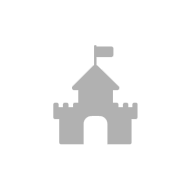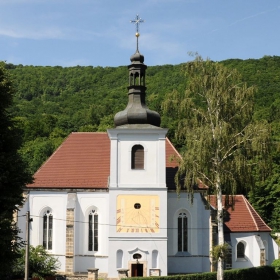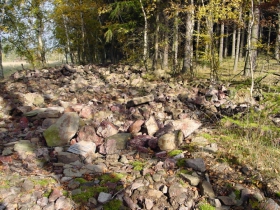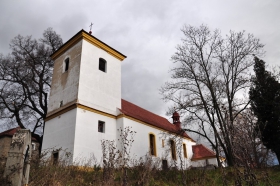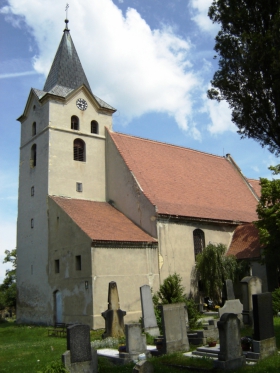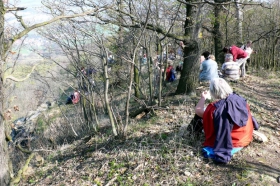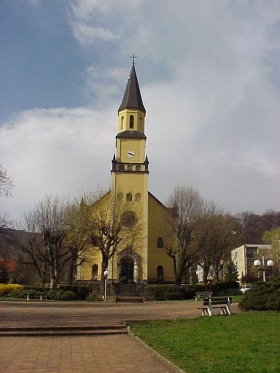Select from ...
Dolní Poohří
Krušné hory
České Švýcarsko
České středohoří
Transport method:









Search results:
St Anne's Church - Malá Veleň (Jedlka)
In 1234 Jedlka became an independent parish and the local church, that was originally wooden, dates back to this time. The locals are well reminded of this data as it is written on the church nave and it is also shown on the roof tiles of the church. The date was recorded by Magdalena Rosenfeldová in the parish chronicle in 1668 and in 1679 it was recorded in the Osterské Records. There also used to be an inscription on the arch of the church, reading 'This house ...
Doupňák Natural Monument
Doupňák was declared a natural monument in 1993 and it covers a total area of 12 hectares. The reserve is found in the district of Chomutov in the region of Ústí nad Labem in the foothills of the Krušné Mountains, not far from the town of Klášterec nad Ohří towards the top of Holubí Peak and adjacent slopes. The protection extents to the historically important mineral deposits of amethyst and jasper, that are ...
The Museum of Czechoslovak Defence System from 1936-1938 - Na Kočičáku
The Museum is situated at the top of the hill known as Na Kočičáku and it consists of reconstructed fortification structures constructed in 1936 and 1937, anti-craft and anti-personnel obstacles, shooting and surveillance corridors. There is also a nature trail providing information on the Czechoslovak fortification system from 1935 to 1937 and on the fatal year of 1938. The Museum allows you to delve into the history of the first half of the 20th century, the harmonic times ...
The Church of Saint Peter and Paul - Žežice
This Gothic church was first mentioned in 1352 and it was renewed after the Hussite Wars in 1470. In 1780 the nave was extended and a new tower was built, also a new vestry and oratory on the sides of the presbytery were added. Some Gothic parts were preserved, in particular in the presbytery, and we can see the coat of arms of the House of Lungwitz who owned the village from the 14th to 16th century. The church was deserted after 1945 and the utterly desolate church was renovated ...
St Laurence Church - Havraň
The Church of St Laurence is first mentioned in 1379. The church is situated on the site of a former Gothic chapel. There is a vicarage near the church. The church is a single nave church ended with a presbytery, a square vestry on the northern side, with a vestibule on the southern side and a prism tower in the northwest corner. The facades are smooth, the windows are pointed with tracery and on the southern side you will find a pointed Gothic portal with a relief stone slab ...
St Wenceslas Church in Malá Bukovina
The beautifully reconstructed Church of St Wenceslas was built at the beginning of the 18th century at the time of peak Baroque. At the end of the 18th century the local priest was Wenzel Hovme, who was viewed as a rather specific individual and who later became the Dean of the Church of the Visitation of the Virgin Mary in Horní Police. At the end of the 20th century this pilgrimage place was reconstructed and it was consecrated on 27 September 2003.
Všechlapy Water Reservoir - Zabrušany
The Všechlapy water reservoir is fed from the two streams going through the village of Zabrušany, nearby a former ancient stronghold. The main purpose of the water reservoir was to ensure the minimum flow of the Bouřlivý (Roaring) Stream below the dam and to ensure a continuous supply of water for the power plant in Ledvice throughout the year, and a sufficient emergency supply for the times when the 'Labe tap' is shut down. The secondary purpose of the ...
Čertí Lake Dam
The Čertí (Devil's) Lake was created when the Pekelský (Hell's) Stream was dammed up in the upper part of Pekelské (Hell's) Valley, situated ca 1.5 km north of the small town of Meziboří. In the past Čertí Lake was one of many water constructions supplying water to the now non-existent mills in the Šumné Valley. The Čertí Lake retained water from Pekelský (Hell's) Stream and helped to supply mills in ...
Rašovice Rocks National Landmark
The walls and plateaus of the rocks are home to many species of thermophilic plants. More than 300 species of tall plants are recorded here, most of them are under special conservation order. In particular, the seriously endangered: small pasque flower, Cheddar Ink but also other endangered species: Golden Alyssum, Common Sundew and Gas Plant. In shady places with deeper layers of soil you will also find the Lesser butterfly orchid, White helleborine, Sword-leaved helleborine, ...
The Church of St Havel - Chlumec
The Church of St Havel is situated in the eastern part of the village of Chlumec. It is a three nave building with a semi-circular presbytery and a prism tower that on the last floor becomes polygonal. The church was built in the first half of the twelfth century and it was dedicated to St Gotthard. In 1590 Petr Kolbel had the church rebuilt in the Baroque style and a prism tower was built. During the Napoleonic Wars the church was seriously damaged. It was renovated in the Neo-Gothic ...













